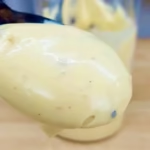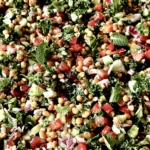Sour Blue Raspberry Pearls
Experience the perfect balance of sweet and sour with these Blue Raspberry pearls. These delightful little bursts of flavour add a pop of colour and excitement to any dish or drink. Elevate your creations with these irresistible flavour pearls.
Equipment
- Syringe, Dropper or Pipette
Ingredients
- 200 ml Torani blue raspberry syrup
- 1 tbsp lemon juice
- 1 tsp gelatin powder or Agar agar, see note #1 & #2.
- 50 ml cold water for blooming gelatin
- 500 ml vegetable oil for setting pearls
- ½ tsp citric acid
Instructions
- In a tall glass, pour vegetable oil and place it in the freezer to chill for about 30 minutes.
- Bloom the gelatin by sprinkling it over 50ml cold water. Let it sit for a few minutes until it absorbs the water.
- In a small saucepan, combine Torani raspberry syrup, lemon juice, and citric acid.
- Heat the mixture over medium-low heat until warm but not boiling.
- Add the bloomed gelatin to the warm blueberry mixture, stirring until the gelatin is completely dissolved.
- Allow the mixture to cool slightly, then transfer it to a dropper or syringe.
- Carefully drop small droplets of the blueberry-gelatin mixture into the chilled oil. The droplets will form pearls as they set in the cold oil.
- Once the pearls are set, use a slotted spoon to scoop them out of the oil.
- Rinse the pearls in cold water to remove excess oil.
Notes
Tips for Making Flavour Pearls / Caviar:
- Consistency of Liquid: Ensure the liquid you are using is free of solids or impurities, as these can affect the consistency and texture of the pearls. A smooth, well-strained liquid works best.
- Temperature of Liquid: The liquid should be at room temperature or slightly warm when adding agar or gelatin to ensure smooth incorporation and avoid clumping. If using agar, be sure to boil the liquid for activation.
- Setting Process: For a smooth, consistent set, make sure the liquid has cooled slightly but is still in a pourable form before dropping it into the setting bath (often oil or cold water). The colder the setting bath, the quicker the pearls will form.
- Size of Pearls: To control the size of your pearls, use a syringe, dropper, or pipette. A finer tip will create smaller pearls, while a larger opening will yield bigger ones. For uniform pearls, consistency in droplet size is key.
- Oil Bath for Setting: To create pearls with a shiny, smooth surface, drop the flavoured liquid into a cold oil bath. Olive oil, vegetable oil, or any neutral oil can work well, and it helps the pearls to solidify without sticking to each other.
- Rinse After Setting: Once the pearls are set, rinse them gently in cold water to remove any excess oil (if using the oil bath method) and ensure they don’t stick together.
- Storage: Flavour pearls should be stored in a liquid that keeps them moist, like the original juice or liquid, to prevent them from drying out. If not used immediately, store them in an airtight container in the fridge. They typically last for about 2-3 days.
- Gelatin vs Agar: Agar will give a firmer texture to the pearls compared to gelatin, which results in a more delicate, softer pearl. You can experiment with both to see which suits your desired outcome.
- Vegetarian Option: To make a recipe vegetarian, replace gelatin with agar agar.
- Agar vs. Gelatin: Agar and gelatin are not directly interchangeable due to their different setting properties. Agar sets firmer and at a lower temperature, which may affect the texture of your final product.
- Gelatin: Derived from animal collagen (typically cows or pigs).
- Agar: Plant-based, extracted from seaweed.
- Gelatin: Sets at a lower temperature, solidifies at room temperature or slightly cooler.
- Agar: Requires colder temperatures to set.
- Gelatin-based pearls: Softer, delicate, and smooth texture.
- Agar-based pearls: Firmer, slightly chewy texture.
- Gelatin: Not suitable for vegetarians or vegans (animal origin).
- Agar: Suitable for vegetarian and vegan diets.
Tried this recipe?
 Mention @thewifewiththeknife or tag #wifewiththeknife
Mention @thewifewiththeknife or tag #wifewiththeknife




